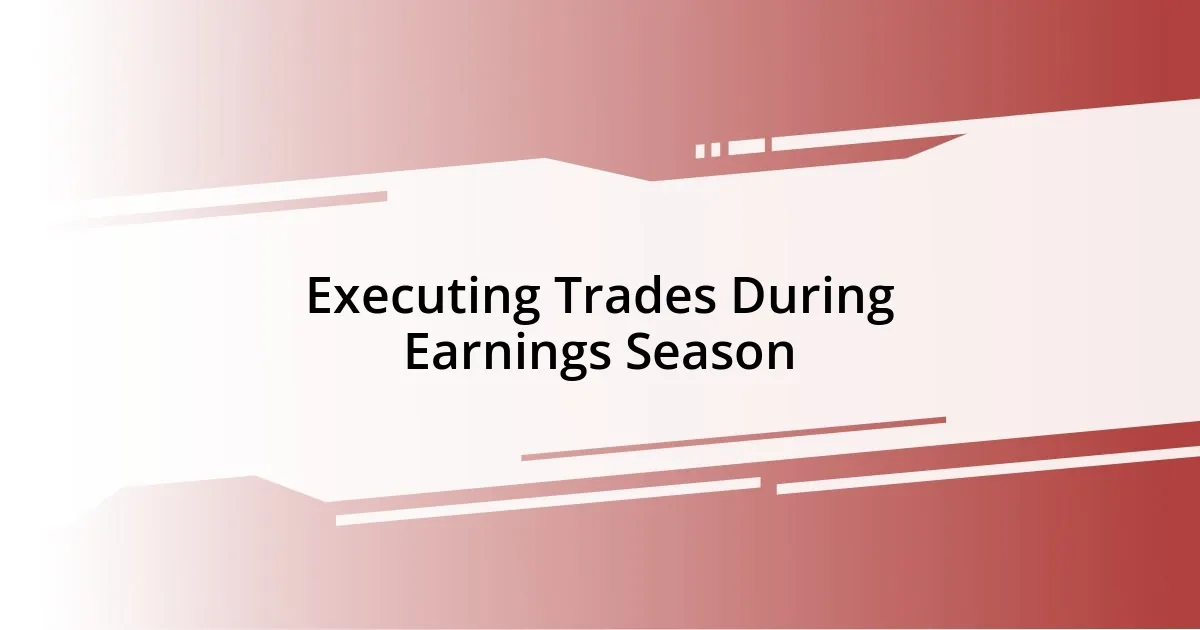Key takeaways:
- Understanding key metrics like revenue and earnings per share is crucial for interpreting a company’s performance and informing trading strategies.
- Timing is critical when trading around earnings reports; entering too early or too late can significantly impact gains.
- Analyzing historical earnings trends helps identify patterns that can provide an edge in trading decisions.
- Post-earnings reviews and adjustments are essential for recalibrating strategies based on market sentiment and reaction, ensuring a grounded approach.

Understanding Earnings Reports
When I first dived into earnings reports, I was overwhelmed by the sea of numbers and jargon. It was like trying to decipher a foreign language! But as I started breaking down key elements—like revenue, net income, and earnings per share—I realized that these figures tell a powerful story about a company’s performance. Understanding how to interpret these metrics can make a huge difference in your trading strategy.
One thing that struck me was how earnings surprises often move stock prices dramatically. Have you ever felt that thrill when a company reports better-than-expected earnings? It’s almost electrifying! Conversely, disappointing earnings can lead to a swift downturn, reminding me of how important it is to anticipate market reactions.
I also found that reading management’s commentary and guidance is just as crucial as the numbers themselves. Their insights can reveal the company’s future direction and help you gauge its economic health. Have you ever noticed how a CEO’s tone can impact your investment decisions? Sometimes, it’s the subtle cues that can offer significant insight!

Importance of Timing in Trading
Timing can truly be everything in trading, especially when earnings reports are involved. I remember one instance where I jumped into a stock right before the earnings release. The excitement was palpable, but in moments like these, the stakes are incredibly high. If you enter too early, you might miss the initial surge, but if you wait too long, you could miss out on potential gains altogether. The thrill of catching the wave just right is something every trader hopes for!
Here are some key considerations about timing in trading earnings reports:
- Pre-earnings anticipation: Traders often strategize around expected performance, trying to gauge market sentiment before announcements.
- Post-earnings volatility: After reports are released, stock prices can swing sharply, offering opportunities for quick trades.
- Market reaction: Observing how similar companies react to their earnings can inform your timing for entry or exit.
- Timing of the release: Earnings often have a set time for reporting, allowing you to plan trades around these predictable moments.
Knowing when to act—and when to hold back—can significantly enhance your trading strategy. In my experience, that sweet spot can often determine whether a trade is a win or a loss.

Analyzing Historical Earnings Trends
Analyzing historical earnings trends can be a real game changer in my trading strategy. When I first started looking at past performance, I noticed patterns that repeated over time. For instance, some companies consistently beat earnings expectations, leading to stock price surges. It’s almost like uncovering a treasure map—seeing where those patterns lead can provide a significant edge in making informed trading decisions.
What really captivates me is how different sectors react to earnings trends. I recall studying a tech company that had a history of lower-than-expected guidance. Every quarter, despite a solid revenue number, the stock would take a hit. It taught me to analyze not just the earnings but also the context around them. Did the company miss out on new customers? Were there macroeconomic factors at play? Understanding these nuances helps refine my trading plan.
| Company | Last 5 Earnings Per Share (EPS) |
|---|---|
| TechCorp | $1.20, $1.30, $1.10, $1.50, $1.15 |
| RetailGiant | $0.90, $0.85, $1.00, $0.95, $1.05 |
| HealthInc | $2.00, $1.80, $2.10, $1.90, $2.00 |

Assessing Market Reactions to Earnings
Market reactions to earnings reports can be fascinating and often unpredictable. I recall one earnings season when a company I closely followed released a stellar report, not just beating expectations but also providing a bright outlook. Yet, instead of soaring, the stock price dipped. It baffled me initially; shouldn’t great news drive up valuations? This experience taught me that context matters—investors were already pricing in high expectations, and anything less than perfection could lead to disappointment.
I’ve learned that comparing immediate market reactions to historical performances is vital. For example, I remember analyzing how a financial firm responded to its quarterly earnings over several years. Despite consistent beats, the market either underreacted or overreacted at times. When delving into these reactions, I wondered: Are investors simply influenced by outside market pressures or the broader economic context? It dawned on me that sentiment often trumps the numbers, making it essential to stay attuned to both the headlines and the market mood.
After the initial excitement or disappointment from earnings releases, volatility can create ripe opportunities for trading. One time, I witnessed a stock plummet after earnings, only to recover a few days later. I hesitated, wondering if it was a buying opportunity or a trap. Ultimately, I decided to respect the data, tracking how the stock behaved post-report, which led me to an excellent entry point. This experience reinforces my belief that active assessment of market reactions can transform fleeting moments into strategic wins.

Developing a Pre-Earnings Game Plan
Before the earnings report drops, I find it essential to create a structured game plan. I like to set clear objectives based on my analysis of past performance. For example, there’s this time I prepared for a biotech firm that historically had volatile movements around earnings. Knowing this, I set specific profit targets and stop losses well ahead of time, which allowed me to navigate the uncertainty with more clarity.
I always focus on gathering comprehensive data, particularly from analysts’ forecasts. I remember preparing for a retailer’s earnings and diving deep into various analysts’ reports. I discovered varying expectations on revenue—noticing the consensus seemed overly optimistic. This led me to position myself more cautiously, which ultimately saved me from unexpected volatility when the results came in below those high forecasts. Have you ever felt blindsided by predictions that didn’t match reality? It’s a reminder of why scrutiny is vital.
Lastly, I keep a close eye on sentiment indicators leading up to earnings announcements, as they can significantly influence market behavior. For instance, I recall a tech giant whose stock was riding high on positive news, only for the sentiment to turn sour just days before the earnings release. I felt the tension in the market, prompting me to reconsider my strategy. That shift allowed me to adjust my expectations and position correctly when the actual earnings were announced. Balancing analysis with sentiment is a key part of my pre-earnings game plan.

Executing Trades During Earnings Season
Executing trades during earnings season is an exhilarating yet careful endeavor. I recall a day when I took a leap with a technology stock immediately after its earnings release. The numbers looked fantastic on paper, and I felt the buzz in the air. But as I watched the stock fluctuate, my heart raced. Was I too quick to act? It reminded me that even in the excitement of good earnings, caution should be my constant companion.
Timing is crucial during this volatile period. I once observed a small-cap stock that shot up nearly 10% right after its earnings call but then retraced almost all its gains by the end of the day. I had been tempted to jump in right at the peak, but something in me held back. Instead, I waited for the dust to settle to gauge genuine interest from other investors. That decision provided more clarity and ultimately led me to a better entry point once the excitement cooled off.
I’ve learned that being mentally prepared for sudden shifts is just as important as the numbers themselves. During one earnings season, I found myself closely monitoring a distressed company whose report was highly anticipated. When the news hit, my initial reaction was disbelief; the stock tanked, which I hadn’t foreseen at all. It’s moments like these that make you wonder: How much weight do we give to expectations versus actual results? Embracing uncertainty and being willing to adapt on the fly has become a key strategy in my approach to executing trades during earnings season.

Reviewing and Adjusting Post Earnings
Reviewing and adjusting my strategy post-earnings is like recalibrating my compass after a storm. One time, I dove into a tech stock that soared after a earnings report but quickly realized I had gotten swept up in the excitement. Reflecting on those quick gains made me pause—was this a sustainable change in valuation, or just a knee-jerk reaction from other investors? I learned that taking a step back to analyze not just the numbers but the broader market sentiment was crucial.
After the dust settles, I often ask myself what went right and what could have been better. I recall analyzing a major retailer’s report that initially led to a spike in its stock price, only for it to reverse course days later. This hindsight taught me to dissect the details, such as earnings quality and guidance, rather than getting lost in superficial reactions. Evaluating these factors ensures I remain grounded and prevents me from riding a potentially volatile wave unfounded caution.
Adjusting my positions based on this analysis can be both an art and a science. I remember when I chose to mitigate my exposure to a pharmaceutical stock after its positive report led to unexpected insider selling. Trusting my instincts to pivot based on post-earnings analysis not only salvaged my profits but also reinforced the necessity of ongoing vigilance. Have you ever felt that rush of realizing a change in strategy is not just wise, but essential? It’s all part of navigating the intricate dance of trading after earnings.














